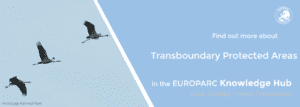Landscape in Escaut Plaines Nature Park (BE) © Escaut Plaines Nature Park
Europe is a complex continent with thousands of years of human interaction overlaying the natural world. The most obvious manifestations of that history are the many political borders that abound, and indeed change over time.
Nature however, never recognises these artefacts of human civilisation and our Protected Areas represent what is most special across our small, marvellous and populated continent and constitute a “shared European inheritance” of nature protection. Yet in places borders create artificial barriers to the management of these valuable natural resources. The places where Protected Areas share a common political boundary bring these management issues into sharp focus and need special consideration.
EUROPARC´s approach to Transboundary Cooperation

The EUROPARC Transboundary Parks Programme “Following Natures Design” and Certificate were developed to respond to these particular needs. It seeks to support a process of mutual understanding, often between countries where history may have created mutual distrust, or administrative barriers and develop management tools to enable greater cooperative management.
Through the certification process, these transboundary Protected Areas, can more effectively manage Europe’s natural resources and aspire to be models of sustainable development.
Based on principles that seek to harmonise the needs of people to use natural areas, these transboundary areas also fundamentally protect the intrinsic value of nature itself.
The TransParcNet, that has emerged from this transboundary work, is a living library of professional experience, which has evolved a vision of a “common future” for Protected Areas where people look beyond the boundaries and transfer knowledge and experience to become important players in nature protection and the social and economic development of their countries.
For more details on the Transboundary Parks Programme of the EUROPARC Federation, feel free to download our brochure “Following nature’s design-Promoting cross-border cooperation in nature conservation”.
